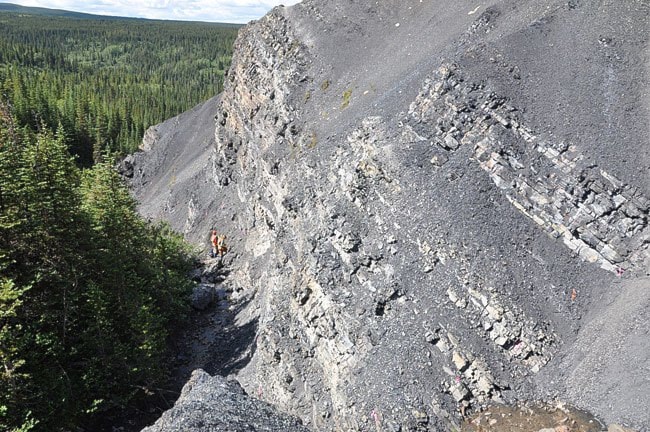The Liard Basin, which straddles the borders of Yukon, British Columbia and the Northwest Territories, is the second-largest known shale gas deposit in Canada and the ninth-largest in the world, according to new research from the National Energy Board.
The basin is expected to contain 219 trillion cubic feet of unconventional shale gas, which is enough to supply Canada’s gas demand for more than 68 years at the 2014 consumption rate.
Mike Johnson, technical leader for hydrocarbon resources with the NEB, said he knew the resource was large, but he didn’t think it was this large.
“You never really know how big it is until you’ve done the calculation,” he said.
About 76 per cent of the deposit is in B.C., with another 20 per cent in the Northwest Territories and the remaining four per cent in the southeast corner of the Yukon.
At eight trillion cubic feet, the Yukon’s deposit is enough to supply all of Canada with natural gas for more than two years.
Carolyn Relf, director for the Yukon Geological Survey, said it dwarfs the Yukon’s combined conventional natural gas resources from all eight known sedimentary basins in the territory.
“I think we were all surprised by the magnitude of the resources,” she said. “I don’t think we would have guessed they’d be this big.”
Relf said it’s possible the Yukon deposit is even larger than the NEB calculated, because only the portion of the basin to the east of the Franklin Mountains was assessed. In the mountain range, she said, it’s harder to calculate how much gas is present because the rocks are “folded and faulted.”
“I think the entire footprint of Liard Basin in our part of the territory ... is probably three or four times the size of what was assessed,” she said. However, that doesn’t mean there’s necessarily three or four times more shale gas.
“There’s too many uncertainties to say that we really know the geology,” Relf said.
But just because the gas exists doesn’t mean it can be extracted anytime soon.
The only natural gas development in the Yukon portion of the Liard Basin was the conventional gas development at the Kotaneelee gas field, which was shut down in 2012. A pipeline exists that fed gas from Kotaneelee into B.C., but it’s not currently being used.
Johnson said there is some current production from conventional gas wells in the Liard Basin in B.C., but there’s no new drilling there either.
“Right now ... gas prices are pretty low, and the cost of doing anything in frontier regions is pretty high,” Relf said. “I don’t think it’s going to make a big difference in the immediate future.”
Still, she added, knowing the resource is there is like “having money in the bank.”
Johnson said the Yukon will face two major hurdles before it can develop the Liard Basin.
The first is the economics of drilling deep wells in remote areas. He said the wells needed in the Liard Basin would be more than 2.5 times larger than other shale gas wells in western Canada, and would cost much more to drill.
“The other big thing is that right now the Yukon’s still setting its policy and regulations around this,” he said. “It comes down to what you want your environmental footprint to look like.”
The Yukon government recently put out a request for proposal for an economic analysis of shale oil and gas development in the Liard Basin, based on the results of this resource assessment.
But the issue is controversial in the territory, given that the natural gas would have to be extracted through hydraulic fracturing, or fracking.
And there are other challenges, too.
“The biggest uncertainty associated with the economic potential of the Liard Basin is the demand for gas or LNG on the B.C coast,” said Allan Fogwill, president and CEO of the Canadian Energy Research Institute. Without new LNG plants in B.C., he said, the demand just won’t exist.
The institute released a study of natural gas development in the Yukon in March 2015. Fogwill said it showed that natural gas from the Eagle Plain basin and the Peel Plateau and Plain would struggle to find an export market, because of declining demand in the U.S. and the extra cost of producing gas in remote regions.
The Liard Basin is at least a little closer to B.C., but Fogwill said it makes more sense for the Yukon to look at replacing diesel with LNG locally, rather than trying to export.
“The idea that this is going to be a significant economic benefit to the Yukon as an export opportunity is hard to see.”
Fogwill added that the Liard Basin wasn’t included in his study because only 2.3 per cent of the land is open for active exploration. He said the rest is off the table for a variety of reasons, including restrictions under the Oil and Gas Act. In comparison, 73 per cent of the Eagle Plain basin is available for development.
Still, Johnson said he’s confident the Liard Basin will be developed at some point, though he’s not sure about the Yukon’s involvement.
“If you go out 10, 20 years, I think so,” he said. “Certainly in B.C., because that’s where testing is going on right now. Elsewhere, hard to know. It really depends on what happens with the markets.”
Contact Maura Forrest at
maura.forrest@yukon-news.com
